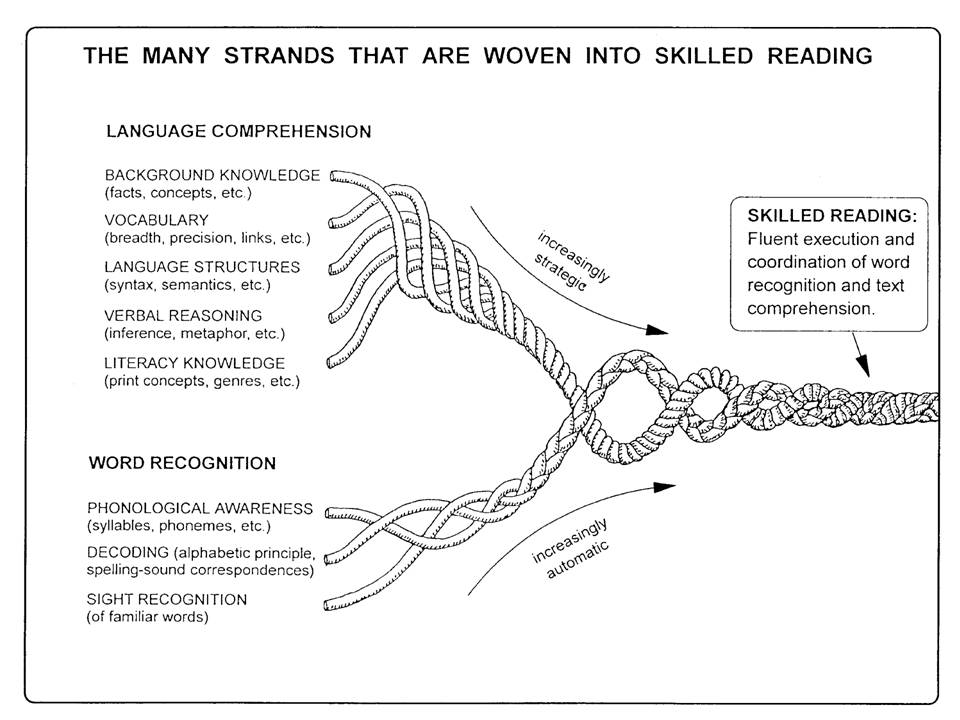ScarbReadingRope
Scarborough's Reading Rope:
Dr. Hollis Scarborough, American psychologist and literacy expert, is the creator of the famous Scarborough’s Reading Rope. Like Gough & Tunmer’s Simple View of Reading, Scarborough replicates the interconnectedness (and interdependency) between decoding and language comprehension in order to establish proficient reading.
These well-validated theoretical models inform educators what to test for and what to teach.
Proficient reading and reading comprehension is the ideal outcome, a product when all strands are tightly woven together. When even one strand is frayed or weak, the overall braided rope is compromised.
Image Credit: The image, courtesy of the author, originally appeared in the following publication: Scarborough, H. S. (2001). Connecting early language and literacy to later reading (dis)abilities: Evidence, theory, and practice. In S. Neuman & D. Dickinson (Eds.), Handbook for research in early literacy (pp. 97–110). New York, NY: Guilford Press.
The top 5 strands become increasingly strategic over time, even into adulthood.
- Background knowledge: The bank of knowledge one possesses based on life experiences and previous learning that is stored in memory and acquired over time.
- Vocabulary knowledge: A language user’s knowledge of words.
- Language structure: Written syntax, sentence structure and text structure. Understanding how sentences are formed and how they convey meaning is critical to our ability to comprehend while we read.
- Verbal reasoning: The ability to put learning into words, to explain answers to the teacher’s questions, to infer, conceptualize and frame thoughts in words – all of these ways of connecting ideas, comparing and contrasting ideas, combining ideas, verbalizing thinking are referred to as verbal reasoning.
- Literacy knowledge: The understanding that organizational differences and purposes exist among different text formats. For example, a poem has a different structure and purpose than an essay. Literacy knowledge includes familiarity with the different expository (non-fiction) text structures that authors use to organize information. These include description, sequence, compare, cause and effect, problem/ solution, as well as the use and purpose of headings, captions, and other organizational features.
The bottom 3 strands become increasingly automatic over time, typically in early elementary school, usually in place by the end of 3rd grade, dependent upon explicit instruction during ELA reading block.
These strands describe how we interact with printed text.
- Phonological Awareness: Awareness of sounds of words in learning to read and spell. (Note: The constituents of words can be distinguished in three ways: (1) by syllables, as /bo˘ok/, (2) by onsets and rimes, as /b/ and /o˘ok/, or (3) by phonemes, as /b/ and /o˘o/ and /k/. (cf. phonemic awareness)
- Decoding (and spelling): (reading). (1) Using one or more strategies to identify a printed word and its meaning; (2) Using knowledge of the logic of the written symbol system (especially letter–sound relationships and patterns in alphabetic orthographies) to translate print into speech; encoding involves translating speech into print using this knowledge.
Alphabetic principle – a letter or letters represents a sound
Spelling reinforces reading more than reading reinforces spelling
- Phonics – word study
- Syllable structure
- Morphology
- Etymology
- Sight Recognition of familiar words: (not sight words or high frequency words) any word whose pronunciation, spelling, and meaning are linked in long-term memory such that it is recognized automatically, effortlessly, and unconsciously when seen in print
**The views and opinions expressed in any third-party resource do not necessarily reflect those of the Arizona Department of Education (ADE) and do not imply an endorsement by ADE.








